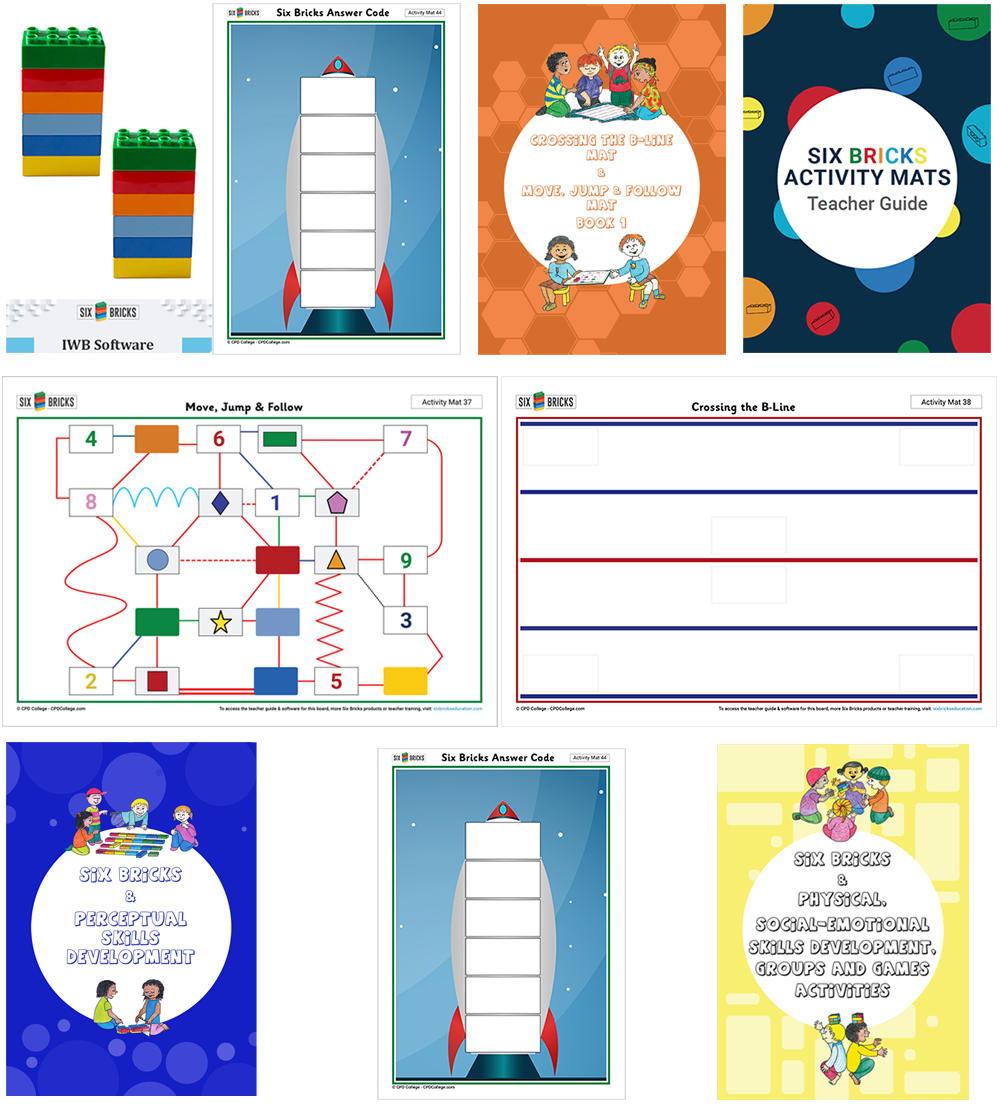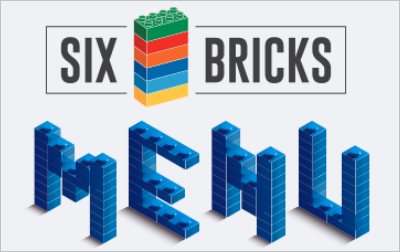
SBSEN - Six Bricks
Putting fun, colour and energy into skills-building for SEN.
If you are a Special Education Teacher working with and supporting students with special educational needs, then this is the course for you!
There is not a more exciting, dynamic or inclusive teaching and learning resource than Lego Six Bricks, and we will introduce you to 100s of skill-building activities across the duration of the course.
Using a collection of just Six Lego Duplo, eight stud bricks & accompanying materials, our CPD College team have created and spotlighted endless ways that just Six Lego Bricks can be used to support inclusive teaching, learning and assessment in the classroom to meet the diverse needs of students, especially those with a diagnosed SEN.
The CPD College team have developed and provide Six Bricks activities and games to practice and strengthen:
- 20 Key Perceptual Skills for SEN, skills that underpin the foundations of learning
- Many concepts, skills and dispositions for SEN across the five strands of mathematics
- Targeted oral language, reading and writing skills for students with SEN
- Assessment approaches through implementing Six Bricks with SEN
- Social, emotional and physical skills & wellbeing for all, but particularly for SEN
Six Bricks is what we term the 'wonder resource' when it comes to intervening and supporting SEN.
Six Bricks is not just educational material; It has now become a pedagogy across curricula in primary schools and particularly in intervention settings.
If you are a SET teacher supporting SEN, then join us to acquire a new tool and set of skills to support highly effective teaching for those children who need it most, the child with SEN.
Enrol today and prepare to confidently step into the world of teaching with Six Bricks!
FREE TO ALL PARTICIPANTS - Incredible Six Bricks Pack (Worth €50) - Sent by Post
You will receive two sets of Six Bricks, four books, two A4 mats and one double-sided A3 activity mats, in the post. See details below.

- 2 x Sets of Six LEGO® DUPLO® Bricks
- 2 x A4 Answer Coding Rocket mats (Mat 44)
- 1 x Book 1 for Crossing the B-Line Mat & Move, Jump and Follow Mat (54 Pages / 165 Activities)
- 1 x Teacher Guide for Activity Mats manual (52 Pages / 44 Activities)
- 1 x Six Bricks & Perceptual Skills Development manual (44 pages / 71 Activities)
- 1 x Six Bricks & Physical, Social-Emotional Skills Development manual (52 pages / 77 Activities)
- 1 x A3 Activity Mats 37&38: Crossing the B-Line Mat Side A / Move, Jump & Follow Mat Side B
FREE TO ALL PARTICIPANTS - Six Bricks software for your IWB
NOTE:
The online format of this course enables you to study at a time and place that best suits your own needs.
You can access your course anytime until March 31st 2026.
Within this highly interactive web-based course, a dynamic learning experience awaits, where you can interact with your fellow course participants through the in-course chat forums and communication tools provided by the CPD College learning system.
Our friendly and knowledgeable tutors actively support each course, providing expert interaction, guidance and feedback for all participants on chat questions and assignments which call for critical reflection, self-analysis and a reasoned response.
On successful completion of your course, you can download and print off your CPD record and certificate of completion.
We look forward to welcoming you to your course.
- Contextual, itemise, incorporate and champion a Six Bricks approach to more effectively supporting children with special educational needs within curriculum
- Create and deploy Six Bricks activities to support the development, strengthening and progression of a vast range of perceptual skills, particularly for children with SEN
- Innovate and incorporate Six Bricks activities, pedagogy, principles and practices to support highly effective teacher practice for language and mathematics skills acquisition and development for all, but especially in SEN
- Productively and effectively incorporate Six Bricks into their mix of assessment approaches and practice
- Use and apply the range of Six Bricks materials, activities and approaches to support the holistic development, diverse needs and wellbeing of all children
- Innovate, design and create their own particular Six Bricks activities for the students they teach, that are child centered and needs based, using a suite of templates provided in the course
- Collaborate, evaluate and plan with SET colleagues to bring Six Bricks into their school and to embed them as a targeted measure to effectively support inclusive teaching, learning and assessment for all, but particularly for special educational needs
|
Module 1 - Developing a range of key perceptual skills through Six Bricks activities: The overarching theme of this module is ‘Perceptual Skills Development’, a crucial area for many children with SEN. We focus in on a methodology that is sweeping the world of play & learning, that of ‘Six Bricks’. We present a cohort of wonderful activities that teachers can engage their students in, often using just six Duplo, 8-stud Lego Bricks, as they build and strengthen children’s full range of perceptual skills. The 20 Key Perceptual Development Skills we describe and exemplar with Six Bricks activities are:
We exemplar how Six Bricks are superb in SEN and include activities which: are open-ended, will allow the child to create or do something, will provide an opportunity for the child to co-operate with others, whilst keeping a sense of self, where the teacher can scale up or down, according to the level of the child and all will be fun, inspire laughter and a love of learning. Our 60+ Six Bricks activities in this module can be practised to develop sensory and perceptual skills in children across the areas above, and can be differentiated further as required. We also detail utilising six bricks as a creative resource for implementing brain breaks for children with additional needs and utilising Six Bricks to support learners with autism (sensory breaks, visual supports for communication, structured play and learning, task focus and sequencing and calming area) Additionally, we detail, scope and provide activities for ‘Six Bricks Ice Breakers and Warm-Up Games that are inclusive of all. |
|
Module 2- Developing Key Mathematical Ideas and Skills with Six Bricks We showcase how Six Bricks embodies a concrete, pictorial, and abstract (CPA) approach to mathematics teaching, learning, and assessment, as developed by American psychologist Jerome Bruner. The process of development in children involves a need to classify what is going on around them and to identify patterns in what they experience. Children learn to fit things together and take them apart as their spatial skills develop. They rearrange and shape objects, and observe and describe things from different spatial views - this is something that can only be learned through experience. This is what our Six Bricks activities support. The manipulation of the concrete 6 Bricks in this section aims to exercise and consolidate: space, spatial relationships, shape, colour, classification, the awareness & concept of numbers, symbols, operations and relationships, one-to-one correspondence, seriation, estimation, counting, comparisons, patterns & algebra, directions, measurement, data handling and chance, problem solving. Our Six Bricks approach and activities will support children in developing their mathematical proficiency through engaging processes, such as connecting, communicating, reasoning, justifying, representing, problem-solving, and generalising, as they play, chat, and work through a sequence of over 70 teacher-led Six Bricks lessons and activities. Through a series of Six Bricks driven lesson plans, teachers will come to understand and know how to incorporate Six Bricks to support productive disposition, adaptive reasoning, procedural fluency and strategic competence as part of the PMC, together with how Six Bricks support a ‘Maths Talk’ approach. |
|
Module 3 - Developing language skills with a Six Bricks approach We focus on using just Six Bricks in all manner of creative ways to support the acquisition and development of language skills. We present enjoyable and motivating Six Bricks oral language stories and tasks that require SEN students to demonstrate joint attention, active listening, and to attend & respond for a particular purpose, simply using combinations of Six Bricks. We present activities that require children to demonstrate understanding through the ability to give and follow instructions, incorporating Six Bricks, showing comprehension of texts like ‘Grobby Six Bricks Farmyard Adventure’, which have been adapted to incorporate physical responses with Six Bricks. To support phonics, word recognition, and word study, we provide a range of hands-on Six Bricks activities and mats to help children practice recognising, naming, and sounding out all 42 letter sounds of the letter sound code. We showcase how to practice blending with the bricks to work out words, and encoding to make words, etc. (overlaying printed combinations of the letter sound code on the bricks). We present six brick-coded charts to practice identifying regular words, the 72 common tricky words, themed vocabulary, and more. We present a selection of six words that are coded and projected in the colours of the Six Bricks, and students must sequence them into a proper sentence using physical bricks. This has huge and unlimited applications. We provide Six Bricks stories and comprehension activities that inspire students to write, illustrate, and read or retell their own Grobby Six Bricks texts. We detail how to incorporate Six Bricks into existing written texts & own texts to support children to respond with a ‘brick’ or by ‘sequencing bricks’. We provide Word Document templates for the letter sound code, Six Bricks adaptable PowerPoints to create their activities, and links to the Six Bricks interactive digital activities. |
|
Module 4 - Six Bricks as part of an effective and inclusive assessment mix Through experiencing a broad range of great Six Bricks activities that are learner outcomes driven, teachers will come to know, understand, appreciate how Six Bricks can be made an effective part of the assessment cycle in all classrooms to support teaching, learning, assessment, SEN and inclusion. When learning tasks are designed around a child and his/her needs and incorporate a Six bricks approach, then teachers can use the bricks to revise old learning, deliver new learning, whilst assessing knowledge, understanding, skills and dispositions based on in-task observations as to how the bricks are being used, combined and applied. We showcase a variety of formal and informal assessment methods with Six Bricks for gathering information about children’s learning, ranging from child-led methods such as self-assessment and conferencing, to teacher-led methods such as teacher-designed tasks and tests. Six Bricks answer code assessments can be created and coded into all five strands of the PMC to support concept acquisition, application, practice, and assessment. We demonstrate how six bricks, in tandem with coded wall charts, can support excellent mental arithmetic and problem-solving across all areas of number. We provide master PowerPoint templates to support assessment codes and their output through the IWB. We showcase how Six Bricks dovetail into the PLC and support active and visible assessment of their letter-sound code knowledge, word reading by blending, identifying tricky words, comprehension skills, spelling, sentence building, e.g., sequencing six coloured words into a proper sentence using their Six Bricks, etc. We share numerous examples in the process of skilling and equipping teachers to create their own targeted assessments for students with special educational needs. |
|
Module 5 - Six Bricks activities to support the physical, social, emotional and wellbeing of all through group games and activities We explore reams of Six Bricks themed activities that teachers can use as are, add to, extend, adapt or differentiate to best support the teaching, learning, assessment and wellbeing needs of students with SEN, together with their peers. Physical Skills Development: Children have a natural urge to be physically active and learn through physical experiences, a ‘Total Physical Response’ approach. Our Six Bricks activities provide children with numerous sensory-motor and fine/gross motor experiences they constantly need, such as activities to help improve muscle tone, balance, proprioception, kinesthetic memory, and hand-eye coordination. We champion Six Bricks in SEN as a way to develop the whole child - the thinking, feeling, moving child! Social-Emotional Skills Development: Cognitive, motor, and language development will be significantly affected by a child's self-perception and their ability to express emotions. The Six Bricks activities in this section aim to contribute to the child’s self-confidence, self-esteem, empathy, respect, ability to develop meaningful and lasting friendships and relationships, ability to experience, manage, and express emotions, ability to make choices, and solve problems. Groups and Games: Belonging to a group is essential to young children. When they enter group settings, they are exposed to behaviours, social rules, and attitudes that enhance social development - all of which are best learned through playing with other children. Our Six Bricks activities support children in practising critical social skills, such as learning ways to cooperate, disagree, share, communicate, assert themselves effectively, accept others’ ideas, express and manage their feelings in appropriate ways, read social situations, control impulses, and compromise. Enrol today and prepare to leverage the power of Six Bricks for teaching, learning and assessment in your classroom or SEN setting! |

Check out our dedicated Six Bricks site at https://sixbrickseducation.com/ From here you can access the Six Bricks Interactive Whiteboard Software and the Six Bricks Shop.

